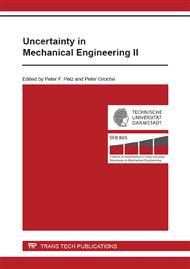[1]
J. Ching, Y.C. Chen (2007), Transitional Markov chain Monte Carlo method for Bayesian model updating, model class selection, and model averaging. Journal of engineering mechanics, 133(7), 816-832.
DOI: 10.1061/(asce)0733-9399(2007)133:7(816)
Google Scholar
[2]
P. Angelikopoulos, C. Papadimitriou, P. Koumoutsakos (2012), Bayesian uncertainty quantification and propagation in molecular dynamics simulations: a high performance computing framework. The Journal of chemical physics, 137(14), 144103.
DOI: 10.1063/1.4757266
Google Scholar
[3]
P.E. Hadjidoukas, P. Angelikopoulos, C. Papadimitriou, P. Koumoutsakos (2015). Π4U: A high performance computing framework for Bayesian uncertainty quantification of complex models. Journal of Computational Physics, 284, 1-21.
DOI: 10.1016/j.jcp.2014.12.006
Google Scholar
[4]
P.L. Green (2015), Bayesian system identification of a nonlinear dynamical system using a novel variant of simulated annealing. Mechanical Systems and Signal Processing, 52, 133-146.
DOI: 10.1016/j.ymssp.2014.07.010
Google Scholar
[5]
D.J. MacKay (2003), Information theory, inference, and learning algorithms (Vol. 7). Cambridge: Cambridge university press.
Google Scholar
[6]
N. Metropolis, A.W. Rosenbluth, M.N. Rosenbluth, A.H. Teller, E. Teller. (1953). Equation of state calculations by fast computing machines. The journal of chemical physics, 21(6), 1087-1092.
DOI: 10.1063/1.1699114
Google Scholar
[7]
P.L. Green, K. Worden. Bayesian and MCMC methods for identifying nonlinear systems in the presence of uncertainty. Philosophical Transactions of the Royal Society A: Mathematical, Physical and Engineering Sciences (in press).
DOI: 10.1098/rsta.2014.0405
Google Scholar
[8]
J. Ching, J.L. Beck, K.A. Porter (2006), Bayesian state and parameter estimation of uncertain dynamical systems. Probabilistic engineering mechanics, 21(1), 81-96.
DOI: 10.1016/j.probengmech.2005.08.003
Google Scholar
[9]
R. Sajeeb, C.S. Manohar, D. Roy (2007), Use of particle filters in an active control algorithm for noisy nonlinear structural dynamical systems. Journal of sound and vibration, 306(1), 111-135.
DOI: 10.1016/j.jsv.2007.05.043
Google Scholar
[10]
M. Khalil, A. Sarkar, S. Adhikari (2009), Nonlinear filters for chaotic oscillatory systems. Nonlinear Dynamics, 55(1-2), 113-137.
DOI: 10.1007/s11071-008-9349-z
Google Scholar
[11]
H.A. Nasrellah, C.S. Manohar (2010), A particle filtering approach for structural system identification in vehicle–structure interaction problems. Journal of Sound and Vibration, 329(9), 1289-1309.
DOI: 10.1016/j.jsv.2009.10.041
Google Scholar
[12]
M.S. Arulampalam, S. Maskell, N. Gordon, T. Clapp (2002), A tutorial on particle filters for online nonlinear/non-Gaussian Bayesian tracking. Signal Processing, IEEE Transactions on, 50(2), 174-188.
DOI: 10.1109/78.978374
Google Scholar
[13]
E.T. Jaynes (2003), Probability theory: the logic of science. Cambridge university press.
Google Scholar


